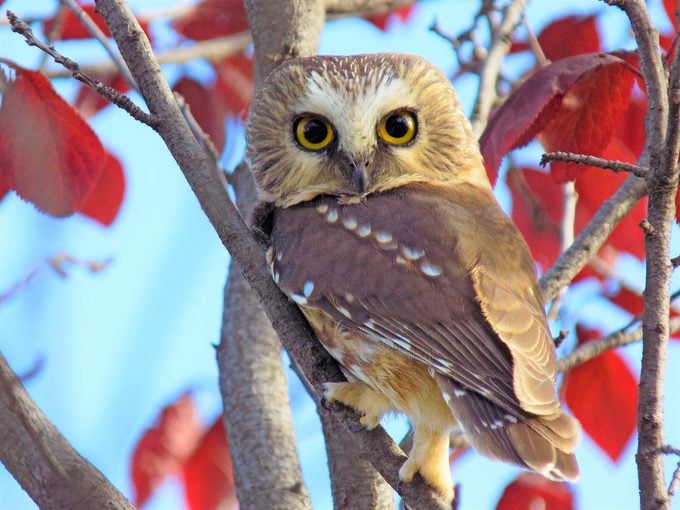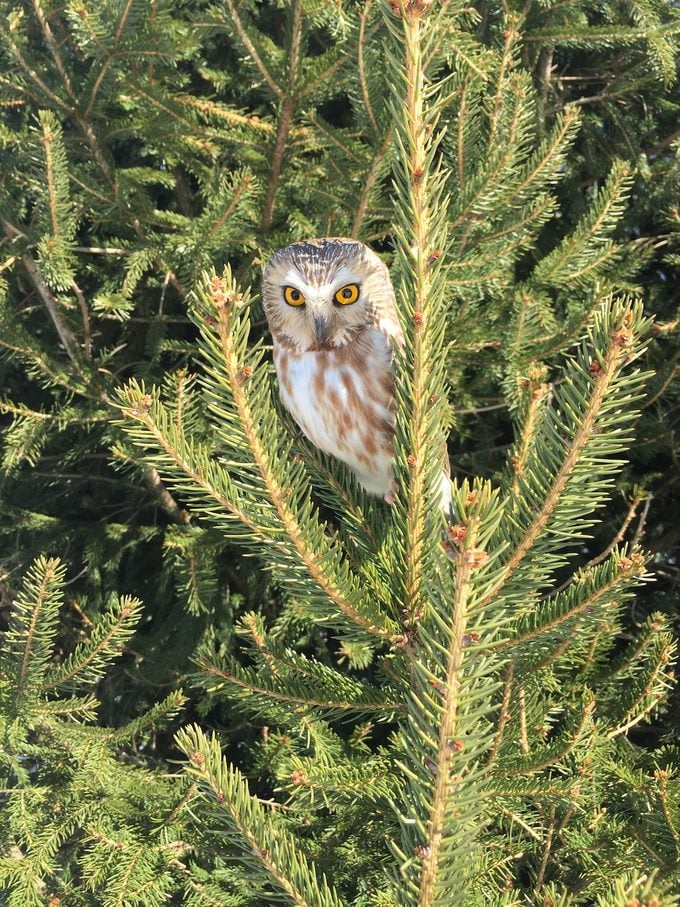How to Identify a Northern Saw-Whet Owl
Updated: Apr. 16, 2024
The northern saw-whet owl is one of the smallest and cutest owls—as long as you aren't a mouse. Learn where you can spot this species.
On This Page
What Do Northern Saw-Whet Owls Look Like?

One of the cutest birds ever, (as voted on by Birds & Blooms readers) is the northern saw-whet owl, and Phil Brown, Bird Conservation Director at the Harris Center for Conservation Education in Hancock, New Hampshire, agrees. “They are one of the most charismatic species,” he says.
The micro sized owls stand around 8 inches tall, roughly the size of a robin. According to Phil, “saw-whets weigh about the same as a stick of butter.”
Although they are fairly common, saw-whets are highly nocturnal and rarely seen.
Round faces with oversized endearing yellow eyes add to their charm. Both males and females look the same with mottled brown plumage. Females are larger than males, but this is difficult to discern from field observations. Instead, biologists assess this with weights and wing measurements.
Age is another characteristic that researchers can determine. Phil says at owl banding stations, researchers shine blacklights on the wing feathers. Younger saw-whet owls shine pink due to higher amount of a chemical on the feathers that breaks down in sunlight. Older birds retain less of this porphyrin, so they are duller under the blacklights.
Discover the amazing types of owls in North America.
Range and Habitat

Northern saw-whet owls breed in the forests of Canada, and in the western mountains south through central Mexico. They also breed in the northeastern states and locally in the higher elevations of the Appalachians. In fall, saw-whet owls spread out from their breeding grounds. Winter range includes much of the Great Lakes, New England and parts of the Midwest. Southern states also see winter arrivals of saw-whets, but in more limited numbers.
Phil explains that “saw-whets have feathers all the way to their toes, an adaption for cold weather survival.”
A key to winter habitat is “dense thickets of conifer trees,” says Phil. Project Owlnet banding efforts like those at the Harris Center have helped researchers determine that not every owl migrates each winter.
The alarm notes of songbirds may draw your attention to a roosting saw-whet owl in dense conifer stands. The nocturnal owl is famously tame if approached, but if you come across one you should give it plenty of space as to not disturb the bird or reveal its location opening it up to harassment from other birds.
You might also see the elusive birds at a banding program as researchers continue to learn more about distribution patterns.
The National Audubon Society Climate Report predicts a 99% loss of current winter range by 2080. Northern saw-whets could be gone from the lower 48 states by the end of the 21st century.
Eastern vs western screech-owl: what’s the difference?
Nesting Habits

During courtship, female saw-whets will respond to the classic “too-too-too” call of males with a “tssst” call or repeated whistles. Males then circle the potential mate multiple times before perching nearby and presenting her with a prey item offering.
Northern saw-whet owls rely on cavities for nesting. “They are secondary cavity nesters,” say Phil, “so they rely on old woodpecker holes.” The species will use nest boxes when placed in appropriate mixed forest habitat, although they don’t generally return to the same cavity for nesting year after year.
Saw-whets tend to lay eggs on the existing debris in chosen cavities without building an entirely new nest. Females lay 4 to 7 smooth white eggs and incubate for nearly a month. Male saw-whets provide almost all of the food supply while the female owls incubate eggs and brood the young birds.
Learn how to attract owls to nest in your backyard.
Diet: What Do Northern Saw-Whet Owls Eat?
Despite their pint size, saw-whets are equipped with the same tools as the larger owls. “They have tiny, hooked raptor bills and sharp talons for killing,” says Phil.
Northern saw-whet owls will eat a variety of flying things including insects, bats, and songbirds, but their main food source is rodents. “They are small mammal generalists,” says Phil.
Every 4 years or so, as small mammal populations surge, saw-whets have a population boost as many young birds survive. These years also show a strong migration push, says Phil.
Larger prey items will be split up into multiple meals. The leftovers are sometimes stashed in tree cavity cupboards.
As with other raptors, rodenticides are a concern for saw-whet owls. The toxins accumulate in the owls if they eat rodents that have been exposed to the poisons.
Did you know: the elf owl is the smallest owl in the world.
Call and Sound
Bird sounds courtesy of the Cornell Lab of Ornithology
Despite being named after the sound of sharpening blades on whetstones, the tiny northern saw-whet owl’s charming, toot-toot calls are hardly menacing.
“They sound like the high-pitched beeps as a truck is backing up,” say Phil. He continues, that saw-whet owls make a variety of other noises including “high pitched squeaks, squawks, and whistles that are often confused with flying squirrel noises.”
Do owl sightings have special meaning?
About the Expert
Phil Brown (he/him) spent his childhood in Staten Island, New York, where he was fascinated with the natural world, especially the birds that passed through his suburban backyard. After undergraduate studies at Rutgers University, he pursued a career in natural resource management. Currently he serves as the Bird Conservation Director for the Harris Center for Conservation Education in Hancock, New Hampshire.
Sources
- National Audubon Society
- Cornell Lab of Ornithology





















